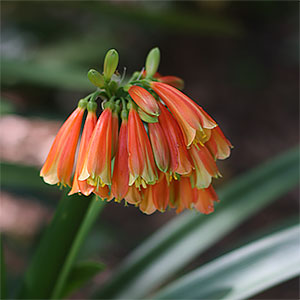
The species Clivia nobilis (C.nobilis) has a wonderful drooping flower and is in our opinion undervalued in the genus. It’s slow growing nature is seen as a disadvantage by many commercial growers, however in full flower C. nobilis is an outstanding specimen plant.
Commonly called the Cape Clivia or Bush Lily, this species is from South Africa’s Eastern Cape Province around Port Elizabeth this was the very first Clivia species discovered, and it’s widespread use in the development of ‘interspecific hybrids’ it certainly is a valuable species.
An ‘old fashioned’ plant found in established gardens in many older areas. With tubular flowers held in a bunch well above the foliage in a pendulous manner these are an easy to grow plant.
The first named Clivia species, after the Noble ‘Lady Clive’ in 1828. And indeed the flowers do have a sense of nobility, a well formed flower head of this species is as beautiful as any of the modern hybrids.
These plants were grown indoors in Victorian times and indeed look most graceful in a pot or container
Clivia nobilis Care.
C.nobilis can be propagated from seed or by division. From seed it may take 7 or more years to flower. Growing conditions and care are similar to other species. A well drained soil in a shaded position, or consider growing in pots or containers as a specimen plant.
Strap like foliage and flower colors ranging from the well known red with green tips through to cream a few named cultivars are around, East London Red and Pearl of the Cape are two.
Summary Information
- Botanical Name – Clivia nobilis
- Common Name – Bush lily or Cape Clivia
- Family – Amaryllidaceae
- Origins – Cape area ofSouth Africa
- Height – To around 80 cm.
- Spread – Clump Forming
- Growth rate – Medium.
- Position – Dappled shade.
- Soil – Free draining
- Flowers – Tubular orange flowers tipped with green..
- Flowering Time – Autumn through to Spring.
- Foliage – Mid to deep green.
- Frost tolerant – Usually protected from frosts by other plants
- Drought tolerant – Yes in a shaded area.
More Clivia Information
American Clivia Society
